Brooklands
Weybridge :
October12, 2001
Brooklands has a very special place in history, As the first motor racing track in Britain it served to nurture new technologies - both for motor racing, and in the fledgling aviation field. Built in 1907 it was the starting point for A.V. Roe and Sopwith, seeing the first public flying exhibition in 1909. It served as a training ground from 1910 till 1939, and as a factory during WWI. Between the wars many important developments occurred at Brooklands - like the first Hurricane flight in 1935. During WWII it was the a production site for Vickers, and continued to be the scene for post-war developments in Aeronautics. Today a 33 acre section is preserved as a Museum. So it was an important stop in our travels.
Getting There:
We were staying in Thames Ditton with Louise's cousin Phil. Our last visit to the UK in 1997 had been for his wedding. Getting from his home to Weybridge was fairly straightforward - although we did need to detour through Surbiton to pick up some stuff. I had a map, but the 'brown signs' made navigation very easy.
The Museum:
We paid our seven pound admission and were able park right in front of the Paddock and Clubhouse. I guess that's the advantage of visiting on a quiet Friday morning. From there we split up as the other two wanted to check out the car stuff, and I wanted to see the aviation collection.
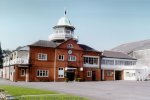
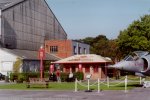
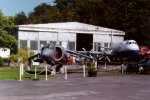
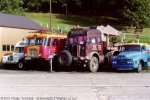
General views from the Paddock at Brooklands looking at (L->R) the Edwardian Clubhouse, the large building housing the stratospheric chamber, with the Shell Petrol Pagoda in front, the Bellman hangar, and vehicles parked beside the replica of the Avro shed.
I had a quick look at the P.1127 and the pre WWI Avro shed. Then it was into the Wellington hangar. This is actually a Bellman hangar erected on the start-finish straight in 1940, and used till the 1980's. As such it is the only listed (grade 2) temporary building in England. I often joke that there's nothing more permanent than a temporary arrangement - but here its certainly the case!


Left: Hawker P.1127 XP984 (the last of the six prototypes and forerunner of the Kestral); Right: the interior of the Avro shed with the replica 1908 Triplane (the actual 1909 Triplane IV is in the Science Museum) BAPC187.
Went straight down the back to have a look at the 'Loch Ness' Wellington. The Wellington is a very rare aircraft today, and this example is the only survivor with a combat history. The conservation team have chosen to preserve rather than restore, and only a minimum of fabric has been replaced. This provides a unique opportunity to see the construction of this classic aircraft. I spent quite some time just looking at the aircraft before I got my camera out.
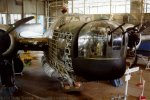
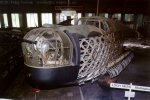
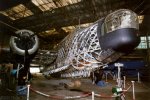
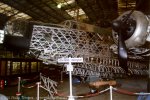
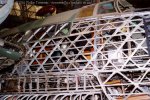


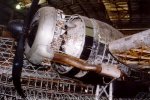
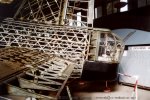
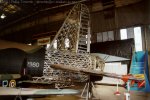
Vickers Wellington Ia N2980 'R for Robert' was ditched in Loch Ness on New Year's Eve 1940 after an engine failure during a training flight. The 1939 vintage aircraft was retrieved in 1985, and has subsequently undergone many 1000s of hours of preservation work at Brooklands. Note the state of the engine cowling - this shows how careful the preservation team have had to be with the delicate airframe.
I stopped to talk to one of the volunteers, who had been showing another how a bomb release worked. This was set up on a frame with a wooden cutout bomb. Apparently it's very popular with the school visitors. He told me that the Museum had just heard that it would be receiving a lottery grant of 994,000 pounds for restoration work on the hangar.Also looked at a Hawker Fury replica which was awaiting covering. Another chance to look at 1930's construction methods.
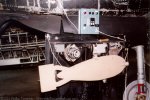
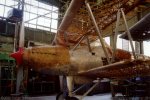

Left: a working example of the bomb release mechanism from a Wellington bomber. Centre & Right: Hawker Fury Replica 'K5637' awaits delivery of linen for covering.
Did manage to look around the rest of the hangar. A Hawker Harrier T.Mk.52, Avro 504 replica, and Vickers Viking caught my attention. I didn't photograph the Camel and some of the other replicas. But there's certainly a wide range of 'real' aircraft. I was directed out the back where I also photographed a Hawker Hunter, Vickers Varsity, and DH.125. Didn't get as far as the big stuff, like the VC.10.
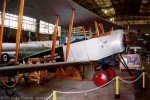
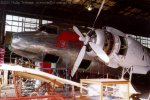

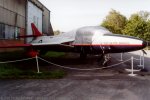
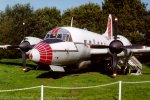
Top Left: Avro 504 (replica) G-AALA is a 'live exhibit'; Top Centre: Vickers Viking Ia G-AGRU undergoing restoration - the 1946 model initially served with BEA and after passing through several owners wound up as a roadside cafe in the Netherlands before being returned to the UK in 1979; Top Right:Hawker Harrier T.Mk.52 G-VTOL is a former company demonstrator built in 1971. Lower Left: Hawker Hunter T.Mk.7 XL621 served with 4 FTS at RAF Valley as '87'. Lower Right:Vickers Varsity T.Mk.1 WF372.
Found Louise wandering around, and we walked up to surviving section of the old race track. It was a pleasant day for a walk in the sun. The banking is surprisingly steep, being about 29' high on this 100' wide section. She then directed me to where the pre-WWI display was - I sent her to see the Wellington.
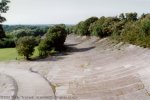
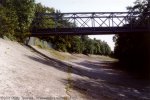
A small section of the original track remains. To the left the entrance to the original start-finish straight on which the Bellman hangar now sits can be seen from the Member's bridge. To the right is the reverse view showing the recreated members bridge above a section of track which illustrates how steep the banking was in places.
The pre-WWI aircraft proved to be replicas. But on the wall was a propeller from Alcock and Brown's Vimy which took my breath away. The display was near the stratospheric chamber which is very impressive. It currently houses the nose of a Valiant. Also in the building a variety of aircraft engines! On my way back I stopped to have a look in the Viscount. This type had operated in New Zealand, but I'd never been up close to one. The volunteer working inside was very friendly and we chatted for some time! I was struck by the radio equipment in the cockpit - we were able to listen in to the Heathrow approach - and some interesting accents.

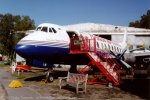
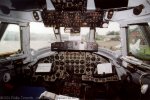
Left: part of the aero engine display. Centre & Right: 1958 Vickers Viscount 806 G-APIM. The aircraft was operated by BEA as 'Robert Boyle' and after moving to British Air Ferries in the 1980s was renamed 'Stephen Piercey' after the photographer. The aircraft had it's nose and cockpit seriously damaged by another taxying aircraft in 1988 and was subsequently offered to the Museum who have restored it.
It was nearly time to meet for lunch by this stage - but I still had time for a quick look through the car section. The Napier Railton was fabulous. Built for John Cobb in 1933, it was powered by the 24litre Napier Lion aero engine. It set the outer circuit lap record (143.44mph) in 1935 and this was never beaten. I was surprised to find the Raleigh bicycle collection - totally unexpected. Must admit to getting nostalgic when I saw the 1976 Raleigh Chopper - how I wanted one of those when I was a kid!
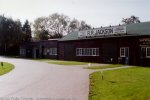
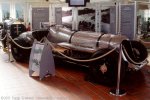
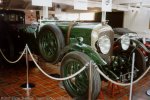
Left: the old racing garages behind the Clubhouse, which have been restored to hold the racing car exhibits; Centre: John Cobb's legendary Napier Railton racing car; Right: exhibits in the car display.
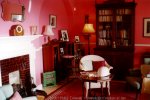 Had a picnic lunch in the paddock. While Louise and Phil were setting this out, I popped into the clubhouse for a look. The Barbara Cartland room ( right ) (or Ladies Reading room) was an eye-opener. Cartland was apparently a regular when she was a newspaper correspondent prior to WWII. The rest of the place just oozed history for me. The shop was a serious temptation.
Had a picnic lunch in the paddock. While Louise and Phil were setting this out, I popped into the clubhouse for a look. The Barbara Cartland room ( right ) (or Ladies Reading room) was an eye-opener. Cartland was apparently a regular when she was a newspaper correspondent prior to WWII. The rest of the place just oozed history for me. The shop was a serious temptation.
After lunch I walked up to the Member's bridge. Stopped to watch squirrels along the way. When I returned it was 1.30ish and time to go. Again I would have liked longer to look around, but I had promised Louise a visit to Hampton Court ...

 © 2002 Phillip Treweek, all rights reserved
© 2002 Phillip Treweek, all rights reserved